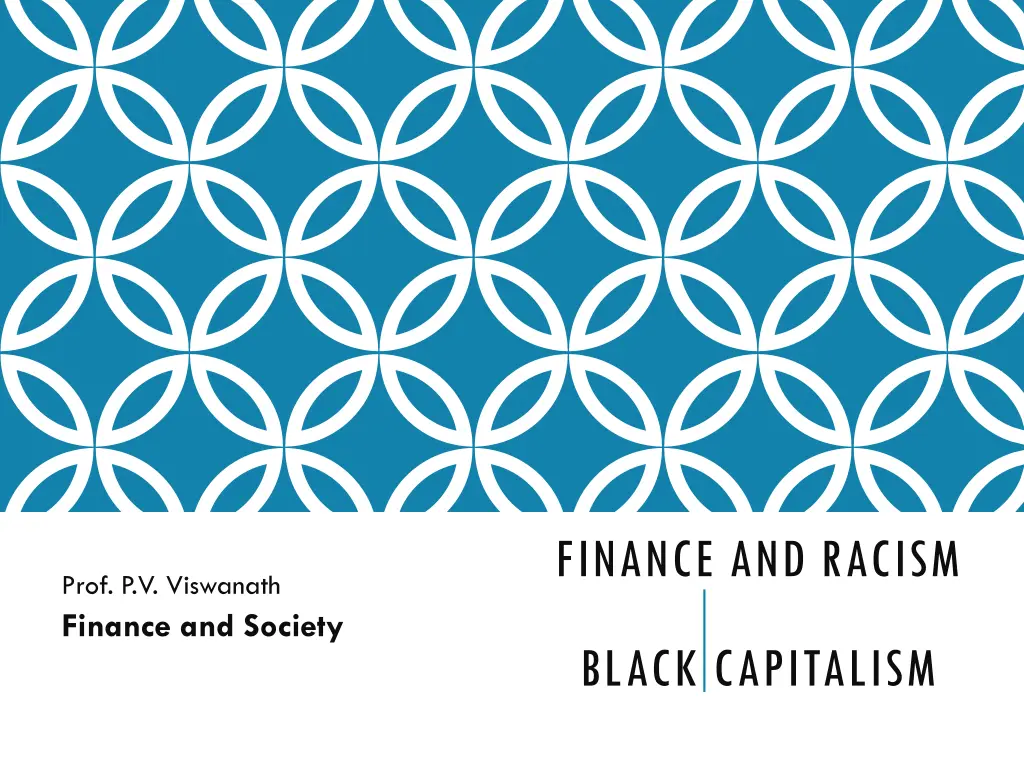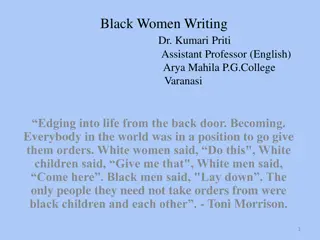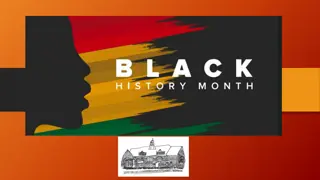
History of Black Entrepreneurship in the United States
Explore the challenges and successes of Black entrepreneurs throughout history, from the difficulties faced in the mid-19th century to the growth during the Golden Age of Black Business in the early 20th century. Discover how racial segregation, economic downturns, and societal resistance shaped the trajectory of Black business ownership in America.
Download Presentation

Please find below an Image/Link to download the presentation.
The content on the website is provided AS IS for your information and personal use only. It may not be sold, licensed, or shared on other websites without obtaining consent from the author. If you encounter any issues during the download, it is possible that the publisher has removed the file from their server.
You are allowed to download the files provided on this website for personal or commercial use, subject to the condition that they are used lawfully. All files are the property of their respective owners.
The content on the website is provided AS IS for your information and personal use only. It may not be sold, licensed, or shared on other websites without obtaining consent from the author.
E N D
Presentation Transcript
FINANCE AND RACISM Prof. P.V. Viswanath Finance and Society BLACK CAPITALISM
BLACK BUSINESS: THE BEGINNINGS Black entrepreneurial activity was very difficult in the South under slavery. However, even in the South, it did exist. In 1860, there were 348 blacks in Baltimore with total property on the order of $449,000. In 1836, 855 free blacks owned 620 slaves as well as real estate worth $2,462,470. In 1860, the total value of all establishments owned by free blacks plus personal wealth amounted to $50m.!
DIFFICULTIES In the mid 19thcentury, black business had to deal with racist attitudes. Here are some examples: White insurance companies usually refused to do business wht blacks. White bankers refused credit to blacks. Black businessmen usually could not sue white creditors in Northern courts. Nevertheless, there were successes, which led lead many blacks to conclude that private enterprise was the road to wealth.
PROBLEMS FOR BLACK BUSINESSMEN The majority of black artisans and potential entrepreneurs in the period after after Emancipation were illiterate. Even where they had occupational skills (such as carpentry), they did not have entrepreneurial training. Many south States declared a black person without a white employer to be a vagrant and subject to arrest. This included entrepreneurs! However, with the development of Jim Crow, black entrepreneurs thrived in black ghettos. This tied into a rhetoric of self-help and racial upliftment. The number of black businesses in the US doubled in a little more than a decade reaching 40,000 in 1914.
GOLDEN AGE OF BLACK BUSINESS AND THE FALL The greatest growth in black businesses occurred in the 1919-1929 period, which was also the period of the most extensive racial segregation. By 1929, the number of black businesses was greater than 70,000. However the Depression hit the black economy hard. For example, the Douglass National Bank of Chicago which had a capital investment of about $300,000 in 1929 and deposits of about $1.5m failed in May 1932. The New Deal benefited many sections of the country, but it often left out minorities. We will see more of this later.
PARTIAL RESUSCITATION During the time of the Great Migration of blacks northward, black business activity also moved north. However, they discovered that there were established Jewish, Irish, Italian and Slavic business owners already established in the ghettos, with access to stable finance. In addition, they practiced Jim Crow hiring policies. Hence blacks did not benefit from the local economy. Blacks in the northern cities boycotted white establishments with racist policies. Black petty capitalists benefited from this. A white majority opposed demands for reparations, integration and even equal resources for schools. Black protests ensued, which turned into a resistance movement and black ghettos erupted in violence. To many, it felt like a domestic war. In the 1950s and 1960s, there was more support from white philanthropists and politicians for local development corporations and economic resource centers because they were worried about their image in the black communities.
PRESIDENT JOHNSONS POLICIES During the last year of his administration, Lyndon B. Johnson assembled the Kerner Commission to study the riots. The report concluded that white institutions created had created the unequal situations in the ghetto and that they maintained it; white society condoned this. President Lyndon Johnson pushed through the1968 Fair Housing Act, which he described as the most important legislation of the civil rights package because it pushed officials to affirmatively further fair housing, meaning to integrate. However, once Nixon came into power, he pursued the road of black capital empowerment instead of integration. In practice, this was disastrous. We will see how supposedly positive policies set up black businesses to fail.
DESCRIPTION OF BLACK BUSINESSES In the 1970s and 1980s, this was the situation for black businesses: 1. almost all are sole proprietorships, unincorporated firms owned by a single black individual 2. most are started by black blue-collar or marginally white-collar employees; 3. 3. the firms are undercapitalized and owners are forced to subsidize business activities by drawing on personal savings, by taking out loans from friends and relatives. 4. Almost all of these firms have no paid employees. 5. the majority are concentrated in two traditional sectors of the segregated black economy, human services and retail trade. 6. at least 75 percent become bankrupt within three years. 7. Most businesses are small with average annual gross receipts vary between $3,000 and $15,000.
QUESTIONS In what follows, we look at how this came about. We will see partial answers to the following questions: 1. Why did government policies not succeed? 2. What are the reasons why black entrepreneurship has lagged? 3. Why did black businesses succeed mostly during times of segregation? 4. Why can t black businesses compete with white businesses? This will allow us to suggest an answer to the question: Is there a future for isolationist economic policies?
NIXON AND BLACK CAPITALISM Nixon rode into office in 1969 on a platform of black capitalism, which effectively meant a segregated black economy, with little actual money budgeted. In 1969 President Nixon signed Executive Order 11458, establishing the Office of Minority Business Enterprise (OMBE) within the Department of Commerce. The OMBE was allocated no direct funds, but was instructed to seek private business contributions and help from other federal agencies. What this meant in real terms was that the OMBE was given responsibility for advising, encouraging, mobilizing, evaluating, collecting, information and coordinating activities, but beyond this vague mission it did not have a mandate or a budget. In 1969 Section 8(a) of the Small Business Act authorized the SBA to manage a program to coordinate government agencies in allocating a certain number of contracts to minority small businesses. But in 1971, with $66m. in federal contracts to minority firms, it amounted to only 0.1% of the $76 billion in total federal government contracts that year.
THE GHETTO AS A SEPARATE ECONOMY Black leaders recognized that there were two separate and unequal economies, but instead of trying to merge the two, they demanded economic control, self-determination and crucially some form of start-up capital to build up the economy of the ghetto. This last element was missing in the Nixon plan. The problem, as Dunbar McLaurin, black ex-banker, recognized, the ghetto is like an underdeveloped country, whose businesses are cut off from the outside economy. Cut off because white clients don t patronize black businesses, but blacks do patronize outside white businesses, thus leading to a leakage as with LDCs. Roy Innis and Floyd McKissick, civil rights activists, proposed creating a Community Development Bank (CDB), which would be part of a Community Development Corporation (CDC). In order to ensure alignment of community incentives with the CDC, each member of the community would be able to buy shares in the CDC. The CDB would offer loan guarantees on mortgage and business loans and would be funded by $400m. worth of Treasury bonds sales. This proposal went nowhere because of opposition from the AFL-CIO and from existing black businesses who saw it as allowing new black businesses to make inroads on their territories.
MESBIC AND EXCESSIVE DEBT The Office of Minority Business Enterprise (OMBE) established by Nixon s executive order in 1969 launched the Minority Enterprise Small Business Investment Company (MESBIC) in 1969, which would provide loans to black businesses willing to lay out initial equity capital worth 15% of total investment. The problem was that this represented a very high D/E ratio, providing little cushion in bad times. This is consistent with what Alicia Robbs (2013) reports in her study on minority access to capital. Minority firms find it difficult to obtain equity investment and end up with unhealthy amounts of debt. In this case, volunteer white firms providing technical assistance took as much as 30% of profits as management fees. The OMBE was reorganized by the Carter administration and continues today in the form of the Minority Business Development Agency as an agency under the Department of Commerce.
EXCESSIVE DEBT In addition, due to lack of capital, the businesses were too small to compete against other firms, recalling the wrong type of firm mentioned by Bateman (2013) in his discussion of capitalist finance. Cut off from the larger economy, ghetto businesses could not take advantage of economies of scale or the robust infrastructure of the outside community. And the few profitable industries in low-income markets were captured by nonblack banks outside the ghetto. As a result, by 1970, 25 of the 50 firms in the program had failed, another 16 were in trouble and the fund itself was bankrupt.
WHITE BANKS AND DISCRIMINATION White banks had branches in black neighborhoods, but they did not hire blacks for anything except the most low-paying jobs. Even teller jobs were considered inappropriate for blacks. It was claimed that bank tellers would undermine customer trust in the bank. White banks also did not lend to ghetto businesses because they were perceived to be risky. Bankers as a rule were risk- averse and this, on top of racism, meant little lending to black businesses. The lack of black loan officers meant that loan decisions were taken by white officers who lived outside the ghetto, did not know their clientele and were disinclined to take risks. A survey of 4000 commercial banks in 1967 revealed that their total investments in minority business in 1967 was $8000 per bank or 0.05% of total bank assets.
BLACK BANKS Discrimination by white banks in hiring and in lending led to an increase in the number of black banks from 24 to 70 between 1969 and 1974 alone. Nevertheless, this represented about 0.05% of total bank assets and deposits. Many blacks deposited their money with black banks. However, their deposits were small and involved high operating costs. In order to help black banks, the 1969 Minority Bank Deposit Program (MBDP) was initiated, whereby government agencies would deposit part of their cash in black banks. However, by law, for government deposits over $100,000, banks were required to hold government securities as collateral of sorts. The banks, themselves, felt obliged to hold Treasury securities as a hedge against the risky loans they made. As a result, according to an FDIC study, black banks held 40% of their assets in low-yielding government securities.
BLACK BANKS Black banks tried to keep to their goal of helping small businesses and home- buyers in black neighborhoods by offering low-cost loans. Unity bank, a black-owned institution, offered low interest loans to marginalized black borrowers and made student loans. Black banks felt obliged to make risky loans to black businesses and home owners. The high unemployment rates, low family incomes, the high failure rates among small businesses (compounded by high crime) make the ghetto an extremely risky lace for small banks to lend money. Bank assets, thus, were either in risky loans or in unprofitable Treasury securities. Bank deposits, on the other hand, were either from small depositors or from unstable government agencies. Furthermore, the Treasury used money from securities sales for money market operations in the broader economy, ultimately helping white businesses outside the ghetto. Hence the deposit program ended up drawing ghetto savings to help white businesses, the very reverse of what it was supposed to do. Consequently, black banks were not able to make use of fractional reserve banking to create credit in the ghetto.
BLACK BANKS The typical black bank was one-third the size of an average commercial bank, as measured by assets, and they were one-quarter to one-third as profitable. Given the circumstances, it was not surprising that black banks did not prosper and often failed. The two largest black banks created in the 1960s were the Unity Bank in the Roxbury neighborhood of Boston (1968) and the Freedom National Bank (FNB) in Harlem (1964). By 1971, the FNB had a loan portfolio consisting of 57% in real estate loans, with 30 percent of those loans in default. The bank lost $704,530 that year and always teetered on the edge of profitability; ultimately, it closed in 1990. The Unity Bank also struggled to make a profit. However, it still exists and continues as a black bank now called OneUnited Bank. In 1968, the number of commercial banks in the U.S. was 14,500. By 2021, this number declined from 6,700. During that time, the number of black-owned banks rose slightly from 20 to 48 in 2001 and 25 in 2021 (excluding credit unions).
THE NEW DEAL AND BLACKS While Nixon pushed black self-reliance and argued that federal spending or reparations in the ghetto was anti-capitalist, government policies during the New Deal (programs enacted by FDR in 1933-39) and after discriminated in favor of whites and against blacks. Most New Deal programs discriminated against blacks. In 1935, the National Recovery Administration (NRA) s minimum wage regulations led to 500,000 Blacks, particularly in the South, losing their jobs. White employers preferred to hire white workers if they had to pay higher wages. The National Industrial Recovery Act of 1933 promoted unionism, but unions were segregated and kept out blacks from good jobs. The Agricultural Adjustment Act (AAA) of 1933 offered white landowners cash for leaving their fields fallow, which they happily accepted; they, however, did not pass on their government checks to the black sharecroppers and tenant farmers who actually worked the land. Since 40 percent of all black workers made their living as sharecroppers and tenant farmers, the AAA acreage reduction hit blacks hard; more than 100,000 blacks were forced off the land in 1933 and 1934.
MINIMUM WAGES, THE GI BILL, SOCIAL SECURITY The minimum wage law, Social Security, unemployment insurance and workmen's compensation provisions of the NIRA did not apply to agricultural workers or domestic household workers at a time when those professions were mainly black. The implementation of the GI Bill of 1944 (aimed to help WWII veterans by providing them with low-cost mortgages, low-interest loans and financial support) worked against black veterans. Because the program was directed by local racist officials, instead of from Washington, blacks were denied housing and business loans, as well as admission to whites-only colleges and universities. Many banks refused loans to black veterans and many Southern colleges did not admit them. Ira Katznelson, author of When Affirmative Action was White documents that they were excluded from job-training programs for careers in promising new fields like radio and electrical work, commercial photography and mechanics. Most African-Americans were channeled toward traditional, low-paying "black jobs" and small black colleges, which were pitifully underfinanced.
BLACKS AND HOUSING PRACTICES The Federal Housing Administration (FHA) promoted racial covenants and other instruments of segregation through underwriting standards discouraging home loans in areas infiltrat[ed] by inharmonious racial or nationality groups. The rationale was the government s need to protect its investment, and those of white homeowners, against the threat African American neighbors would pose to property values. The Federal government actively engaged in housing discrimination in many ways. For example, the Home Owners Loan Corporation, the Federal Housing Administration and the Veterans Administration, which insured mortgages, used maps to exclude areas where Blacks lived. Because of this, many developers created housing deeds that stipulated that a house could only be not be sold to Blacks. In addition, the FHA recommended different ways to keep Black and white neighborhoods separate. From 1940 to 1945, nearly 14,000 African Americans flowed into Richmond, CA, a small Pacific Coast shipbuilding city, to work in factories. The government housed them in poorer-quality, officially segregated buildings, setting aside better homes for whites. This established segregated living patterns that persist to this day, according to Richard Rothstein, author of Color of Law. Because of the way the GI Bill was implemented, "fewer than 100 of the 67,000 mortgages insured by the G.I. Bill supported home purchases by nonwhites.
THE LEGACY OF DISCRIMINATION The bottom line is that not only during the period of slavery, but with active governmental participation also during the first half of the 20th century, blacks were discriminated against in favor of whites to the extent that wealth and income disparities continued to persist. And these disparities have even increased over the last three decades. Contemporary poverty and inequality are related to blacks' historical disadvantage in accumulating wealth. Black wealth accumulation was stunted both by slavery and its successors, sharecropping, Jim Crow laws and overt economic discrimination against blacks. Blacks were unable to begin accumulating wealth until a much later date compared to non- Hispanic whites. This wealth disadvantage is a result of the successive coercive systems replacing slavery and is one of slavery's legacies. Historical discrimination affects the present generations outcomes via the wealth earlier generations passed on. Wealth from parents, for example, has a large impact on an adult child's ability to buy a house and on the location of that house (Shapiro 2004). The link between neighborhoods and public schools ensures the quality of education, and therefore future job outcomes, of children within historically disadvantaged categories are affected by wealth accumulation.
DISCRIMINATION By discriminating against blacks and shutting them up geographically in ghettos, the white economy had cordoned off a segment of risky borrowers. Furthermore, by pursuing policies that benefited whites against blacks, as explained above, whites were able to enjoy an economy with lower prices for goods, credit and housing. Since education was tied to housing, such discrimination also resulted a combination of all-white suburbs, lower competition for lucrative jobs, and labor protections that benefited whites against blacks. The financial system, too, benefited from government largesse because the credit markets that lent primarily to whites lay atop a federal government apparatus including guarantees, secondary markets, deposit insurance and Federal Reserve support.
CONCLUSION The theory behind developing a separate black economy had been that economic power would lead to political power, but perhaps they had it backward. If the rollout of the black capitalism program had demonstrated anything, it was that economic power could not be achieved without government help. American businesses, banks, and homeowners had all benefited from being inside the power structure and receiving its bounty. Blacks had been on the outside, and their lack of political control translated into a lack of economic power. The lesson seems to be that until black people can access the levers of political power, they cannot unleash government or business support, both of which are essential for economic success. Starting from behind, the black community finds that the concentration of wealth in the white capitalistic setup is difficult to break into. Some in the black community demand reparations, but the moral aspect aside, it is a demand for capital in order to remedy past exclusion that has impoverished the community.
BIBLIOGRAPHY https://bostonreview.net/class-inequality-race/mehrsa-baradaran- bad-check-black-america Baradaran, Mehrsa. The Color of Money: Black Banks and the Racial Wealth Gap, Belknap Press of Harvard University Press, 2017. Katznelson, Ira. When Affirmative Action was White. Rothstein, Richard. Color of Law. Robb, Alicia. Access to Capital among Young Firms, Minority-owned Firms, Women-owned Firms, and High-tech Firms, Small Business Administration Office of Advocacy, April 2013. Bateman, Milford (2013). Financing local economic development: in search of the optimal local financial system. In: FSE (Hg.) sterreichische Entwicklungspolitik, Analysen Informationen mit dem Schwerpunktthema Private Sector Development Ein neuer Businessplan f r Entwicklung? , Wien, 43-52 Berichte






















